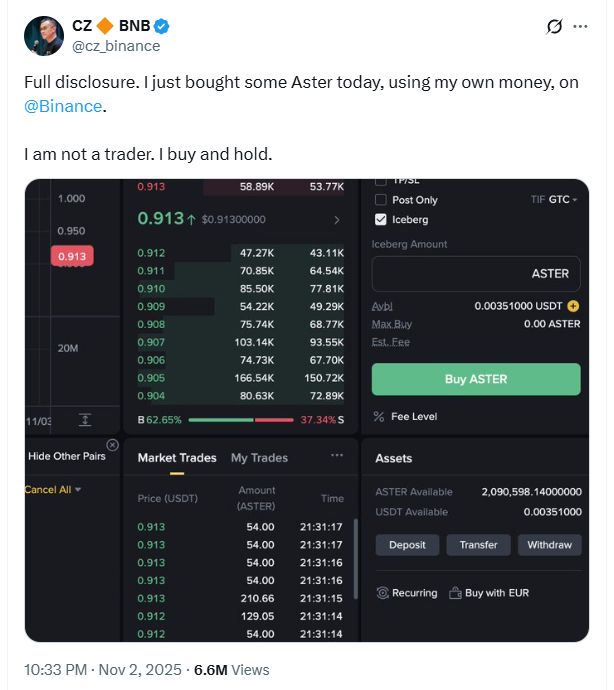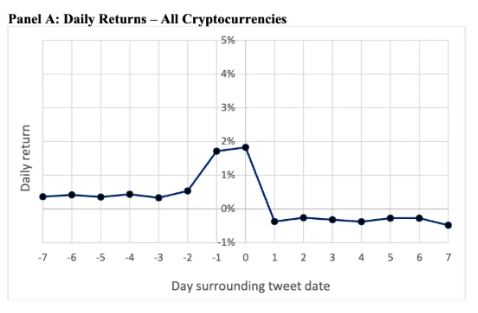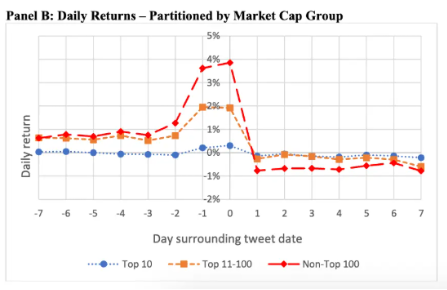A single tweet from CZ can trigger billions of dollars in trading volume, while at the same time, global currency markets are signaling tightening liquidity, and massive funds are struggling to choose between major coins and altcoins.
"I used my own money to buy some ASTER on Binance. I am not a trader, I buy and hold." On November 2, Binance founder CZ (Changpeng Zhao) posted this brief statement on X, instantly igniting the long-dormant altcoin market.
ASTER's price soared 27% within minutes after the news was released, reaching a multi-week high of $1.27. On the other side of the market frenzy, two whales quickly established more than $71 million in ASTER short positions, marking the beginning of a long-short battle.

I. Event Review: CZ’s Personal Purchase of ASTER Sparks Market Frenzy
CZ’s tweet was not just a simple purchase statement, but also contained several intriguing details, quickly interpreted by the market as his public endorsement of the ASTER project.
● According to the account screenshot and market data shared by CZ, he purchased about 2.09 million ASTER tokens. At the purchase price of about $0.913, this investment was worth nearly $2 million. He specifically emphasized that it was "personal funds" rather than institutional funds, and clearly stated, "I am not a trader, I will hold after buying," indicating his long-term investment stance rather than short-term speculation.
● After CZ posted the tweet, ASTER’s derivatives trading volume soared by 186%, reaching $3.04 billion, showing the market’s high sensitivity to this news.

II. Celebrity Endorsement Effect
CZ’s endorsement of ASTER is not an isolated incident, but the latest manifestation of the long-standing celebrity effect in the cryptocurrency market. This effect can generate astonishing returns in the short term, but long-term performance is often disappointing.
● According to research published in May 2024 by researchers from Harvard Business School and other institutions, after cryptocurrency KOLs endorse a token, the average one-day return is 1.83%, but for tokens outside the top 100 by market cap, this figure jumps to 3.86%. However, this surge is hard to sustain. The study shows that the average return from the second to the fifth day after the tweet is -1.02%, and more than half of the initial gains are erased within five days.
● In the longer term, the average cumulative returns 10 and 30 days after the tweet are -2.24% and -6.53%, respectively. Investing $1,000 in non-top-100 tokens and holding for 30 days results in an average loss of $79. The study also found an interesting phenomenon: when influencers claim to be experts, post-event returns are even more negative; and those with more followers who claim to be experts have even worse token recommendations.


III. Global Tightening and Capital Flows
The CZ ASTER endorsement occurred against a macro backdrop of multiple liquidity challenges facing the entire cryptocurrency market, as global currency markets are generally signaling tightening liquidity.
Global Liquidity Tightening Trend is Obvious
● Key secured lending indicators in the US and UK have both risen to levels not seen in years. Although the driving factors differ, signs of liquidity tightening are appearing in both markets.
● The Federal Reserve’s main liquidity tool, the reverse repo facility, is almost unused, and bank system reserves have declined. The overnight general collateral repo rate once reached 4.32%, exceeding the Fed’s benchmark rate. This liquidity strain is not unique to traditional markets. Lin, APAC business head at crypto derivatives exchange Deribit, pointed out that current market liquidity is still 15%-20% worse than before the "10.11 crash".
Altcoins Become a Liquidity Safe Haven
● Amid overall liquidity tightness, funds are flowing from major coins to altcoins in search of higher returns. Andrew Tu, an executive at quantitative firm Efficient Frontier, believes that traders may be taking profits from bitcoin and moving them into altcoins.
● This is confirmed by ASTER’s market performance. Despite the overall lack of market liquidity, ASTER managed to attract massive inflows, with derivatives trading volume surging 186% in a single day, indicating that in a liquidity winter, funds are more inclined to chase short-term high-return opportunities.

IV. Fierce Battle Between Whales and Retail Investors
This market frenzy triggered by CZ did not result in a unanimous bullish sentiment, but quickly evolved into a long-short battle between whales and retail investors, highlighting the huge current market divide.
● After CZ’s bullish statement, two whales acted quickly, opening more than $71 million in ASTER short positions, in sharp contrast to CZ’s bullish stance. One whale’s shorting strategy was particularly aggressive. He initially shorted 42.96 million ASTER tokens with 3x leverage, entering at $1.208, with a liquidation threshold between $1.8085 and $2.0858.
● This high-risk strategy means that if ASTER’s price continues to rise, the whale will face huge liquidation pressure. This also demonstrates the market’s disagreement over the value of tokens endorsed by CZ—some see it as an investment opportunity, while others view it as overhyped speculation.
● On the other hand, on-chain data also captured bullish signals. One large holder withdrew 6.8 million ASTER tokens from Binance and transferred them to the Aster ecosystem within six days, indicating that some large players are preparing for a possible price surge.
V. Rational Thinking Behind the Frenzy
Although CZ’s endorsement of ASTER brought a short-term price spike, the risks involved should not be ignored. Historical experience shows that following celebrity endorsements is often not a wise move in the long run.
Short-term Volatility Risks Intensify
● The large short positions held by whales are in direct confrontation with CZ’s bullish stance. If ASTER’s price rises further, it could trigger large-scale short liquidations, intensifying market volatility.
● On the other hand, if the whales’ shorting strategies succeed and ASTER’s price falls, retail investors who followed the trend may face significant losses. The long-term returns of crypto KOL endorsements are generally negative, especially for small-cap tokens.
● Looking back at @boldleonidas’s trading experience, after the last time CZ promoted a token, thousands of "Brocolli" variants appeared, causing him to lose his entire position in BNB, leading him to vow never to participate in such recommendations again.
Opportunities and Challenges in the Liquidity Dilemma
● Against the backdrop of insufficient overall market liquidity, the practice of arbitraging altcoins also faces greater risks. When market liquidity is still 15-20% worse than before the "10.11 crash", any major market fluctuation could cause liquidity to dry up instantly, making it impossible for investors to close positions in time.
● In addition, although ASTER’s derivatives market open interest reached $437 million, quarterly trading volume fell by 40.55%, indicating that market participation may not be balanced. Looking back at the October 11 crypto market crash, that chain liquidation crisis was triggered by hidden systemic leverage mismatches in circular loan arbitrage and the failure of exchange liquidity mechanisms, reminding investors not to ignore systemic risks when chasing high returns.





